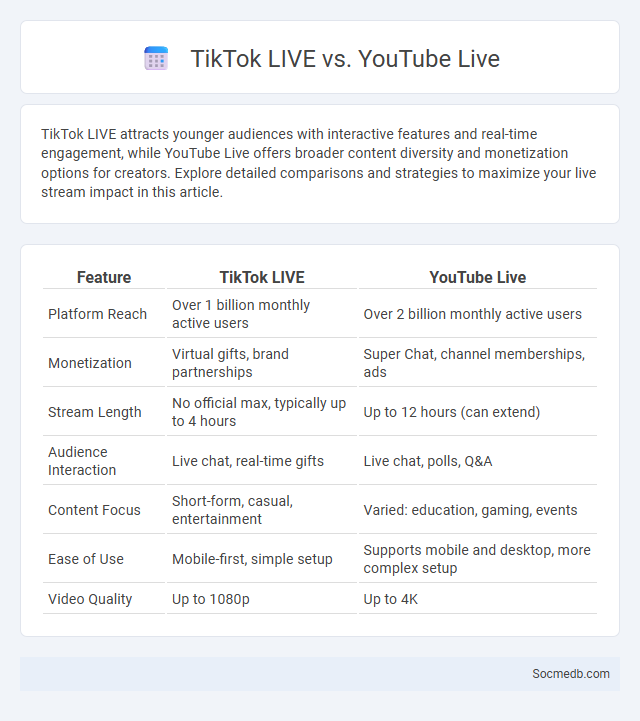
Photo illustration: TikTok LIVE vs YouTube Live
TikTok LIVE attracts younger audiences with interactive features and real-time engagement, while YouTube Live offers broader content diversity and monetization options for creators. Explore detailed comparisons and strategies to maximize your live stream impact in this article.
Table of Comparison
| Feature | TikTok LIVE | YouTube Live |
|---|---|---|
| Platform Reach | Over 1 billion monthly active users | Over 2 billion monthly active users |
| Monetization | Virtual gifts, brand partnerships | Super Chat, channel memberships, ads |
| Stream Length | No official max, typically up to 4 hours | Up to 12 hours (can extend) |
| Audience Interaction | Live chat, real-time gifts | Live chat, polls, Q&A |
| Content Focus | Short-form, casual, entertainment | Varied: education, gaming, events |
| Ease of Use | Mobile-first, simple setup | Supports mobile and desktop, more complex setup |
| Video Quality | Up to 1080p | Up to 4K |
Introduction to Live Streaming Platforms
Live streaming platforms revolutionize real-time content sharing by enabling you to broadcast video directly to your audience with minimal delay. Popular services like Twitch, YouTube Live, and Facebook Live utilize advanced streaming technology to support interactive features such as live chat, reactions, and virtual gifts. These platforms optimize engagement, making them essential tools for influencers, brands, and content creators to build authentic connections instantly.
Overview: TikTok LIVE, YouTube Live, and Livestream
TikTok LIVE offers immersive, real-time interaction through short-form video streaming, engaging millions globally with dynamic content and instant audience feedback. YouTube Live leverages vast content diversity and robust monetization tools, enabling creators to broadcast high-quality streams to a global audience while fostering community growth. Your successful livestream strategy benefits from understanding these platforms' unique features and tailoring content for maximum viewer engagement and reach.
Audience Reach and Demographics Comparison
Social media platforms vary significantly in audience reach and demographics, with Facebook boasting over 2.9 billion monthly active users primarily aged 25-34, while Instagram appeals heavily to the 18-34 age group with approximately 1.5 billion users. LinkedIn targets professionals and B2B markets, attracting over 900 million users with a majority aged 30-49, making it ideal for business-oriented content. TikTok, with more than 1 billion users, dominates younger demographics, especially Gen Z, emphasizing short-form video content that drives high engagement rates across global markets.
Streaming Features and Capabilities
Social media platforms now integrate advanced streaming features that enable real-time video broadcasting with interactive elements such as live chat, polls, and virtual gifts, enhancing user engagement and content reach. With high-definition streaming and low latency technology, creators can deliver seamless live experiences to your audience, increasing viewer retention and participation. These capabilities empower influencers and brands to build authentic connections, boost visibility, and monetize content effectively across diverse social networks.
Monetization Options and Revenue Potential
Social media platforms offer diverse monetization options including sponsored content, affiliate marketing, and in-app purchases, empowering creators to turn their engagement into steady income streams. You can leverage ad revenue sharing programs and premium subscription models to maximize your revenue potential while building a loyal audience. By strategically utilizing platform-specific tools like Instagram Shopping or YouTube Super Chats, content creators increase their earning opportunities significantly.
User Experience and Interface Differences
Social media platforms vary significantly in user experience and interface design, with elements tailored to target audiences and content types. Visual-centric apps like Instagram emphasize sleek, image-heavy interfaces with intuitive gestures, while Twitter focuses on textual content with streamlined timelines and real-time updates. User experience is further enhanced through customizable settings, interactive features, and algorithm-driven content feeds that prioritize engagement and ease of navigation.
Engagement Tools and Interaction Features
Engagement tools and interaction features on social media platforms enhance Your connection with audiences by enabling real-time communication through comments, likes, shares, and direct messaging. Features such as polls, stories, and live videos increase user participation and foster community building. Leveraging these tools effectively boosts visibility, encourages active involvement, and strengthens brand loyalty.
Platform Algorithms and Discovery
Platform algorithms prioritize content based on user engagement, relevance, and personalization, influencing what appears in your feed and discovery sections. These algorithms analyze your behavior, such as likes, shares, and time spent on posts, to curate a tailored experience that increases content visibility and interaction. Understanding these mechanisms can help you optimize your content strategy for better reach and audience growth across social media platforms.
Content Policies and Moderation
Social media platforms implement comprehensive content policies to regulate user behavior and prevent harmful or illegal material such as hate speech, misinformation, and explicit content. Moderation strategies combine automated algorithms with human reviewers to detect and remove violations, ensuring user safety and compliance with legal standards. Transparent enforcement of these policies fosters trust and encourages responsible digital communication across global user communities.
Choosing the Best Platform for Your Needs
Selecting the best social media platform depends on your target audience demographics, content type, and engagement goals. Platforms like Instagram and TikTok excel in visual content targeting younger audiences, while LinkedIn suits professional networking and B2B marketing. Analyzing user behavior and platform analytics ensures alignment with your brand's objectives and maximizes reach.
 socmedb.com
socmedb.com